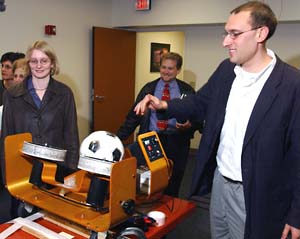Headbands intended to protect soccer players from head injuries are effective only at high speeds, according to a team of University researchers.
The group found that all four brands of commercial headbands eased the impact of a soccer ball at the highest speeds and pressures tested but failed to reduce the force at slower speeds.

“These early findings imply that soccer headgear is not very protective during run-of-the-mill impacts in soccer, but may protect against more severe collisions, such as hitting a goalpost or another player’s head,” said Rosanne S. Naunheim, M.D., associate professor of medicine. “Effectively, these headbands protect players against the same things a helmet would protect them from but do not provide specific protection against hitting a soccer ball.”
Naunheim led the study along with Philip V. Bayly, Ph.D., associate professor of mechanical engineering in the School of Engi-neering & Applied Science. The findings appeared in a recent journal of Academic Emergency Medicine.
About 200 million people worldwide play soccer, yet there is little research on the neurological dangers of hitting a soccer ball with the head, a common practice called “heading.”
“It’s going to take long-term studies to find out precisely how dangerous it is to hit a soccer ball with your head,” Naunheim said.
She and a team of University engineers are exploring the physical properties and neurological repercussions of soccer heading. Meanwhile, they tested four brands of headbands currently available using a magnesium head-simulator.
Soccer balls were projected from 10 feet away at 20, 26 and 34 mph. The team also tested two levels of ball inflation to measure the effect of ball pressure.
All four headbands significantly changed the impact of the ball when it was fully inflated and projected at the highest speed. However, at both other speeds, none of the headgear provided significant protection against impact, regardless of inflation.
“At the highest speeds there’s a possible protective effect, so there might be an even greater effect at faster speeds,” Naunheim said.
Because soccer balls can reach velocities of 85 mph in professional matches, the team plans to test the headbands under more forceful conditions.